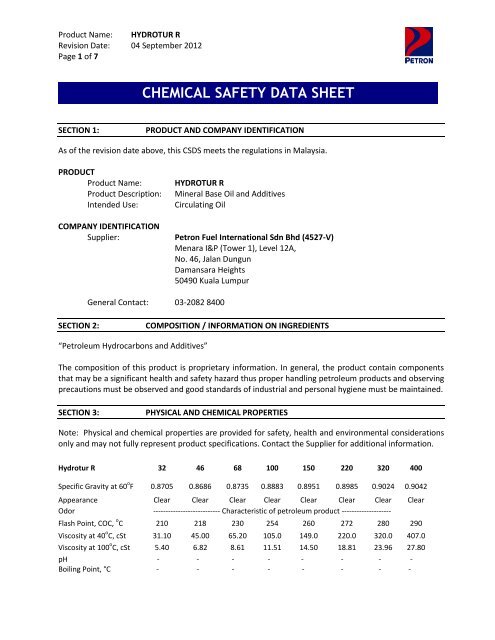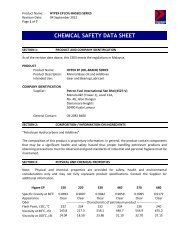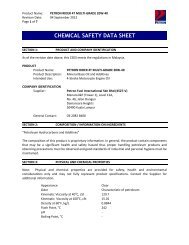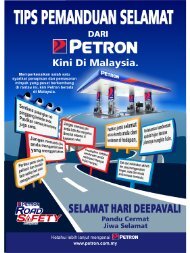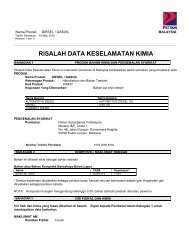(E) PDF here - Petron
(E) PDF here - Petron
(E) PDF here - Petron
Create successful ePaper yourself
Turn your PDF publications into a flip-book with our unique Google optimized e-Paper software.
Product Name: HYDROTUR R<br />
Revision Date: 04 September 2012<br />
Page 1 of 7<br />
CHEMICAL SAFETY DATA SHEET<br />
SECTION 1:<br />
PRODUCT AND COMPANY IDENTIFICATION<br />
As of the revision date above, this CSDS meets the regulations in Malaysia.<br />
PRODUCT<br />
Product Name:<br />
Product Description:<br />
Intended Use:<br />
COMPANY IDENTIFICATION<br />
Supplier:<br />
HYDROTUR R<br />
Mineral Base Oil and Additives<br />
Circulating Oil<br />
<strong>Petron</strong> Fuel International Sdn Bhd (4527-V)<br />
Menara I&P (Tower 1), Level 12A,<br />
No. 46, Jalan Dungun<br />
Damansara Heights<br />
50490 Kuala Lumpur<br />
General Contact: 03-2082 8400<br />
SECTION 2:<br />
COMPOSITION / INFORMATION ON INGREDIENTS<br />
“Petroleum Hydrocarbons and Additives”<br />
The composition of this product is proprietary information. In general, the product contain components<br />
that may be a significant health and safety hazard thus proper handling petroleum products and observing<br />
precautions must be observed and good standards of industrial and personal hygiene must be maintained.<br />
SECTION 3:<br />
PHYSICAL AND CHEMICAL PROPERTIES<br />
Note: Physical and chemical properties are provided for safety, health and environmental considerations<br />
only and may not fully represent product specifications. Contact the Supplier for additional information.<br />
Hydrotur R 32 46 68 100 150 220 320 400<br />
Specific Gravity at 60 o F 0.8705 0.8686 0.8735 0.8883 0.8951 0.8985 0.9024 0.9042<br />
Appearance Clear Clear Clear Clear Clear Clear Clear Clear<br />
Odor --------------------------- Characteristic of petroleum product --------------------<br />
Flash Point, COC, o C 210 218 230 254 260 272 280 290<br />
Viscosity at 40 o C, cSt 31.10 45.00 65.20 105.0 149.0 220.0 320.0 407.0<br />
Viscosity at 100 o C, cSt 5.40 6.82 8.61 11.51 14.50 18.81 23.96 27.80<br />
pH - - - - - - - -<br />
Boiling Point, °C - - - - - - - -
Product Name: HYDROTUR R<br />
Revision Date: 04 September 2012<br />
Page 2 of 7<br />
Pour Point, °C - - - - - - - -<br />
Vapor Pressure, kPa - - - - - - - -<br />
Vapor Density - - - - - - - -<br />
Solubility in Water ---------------------- Not soluble /Immiscible ----------------------<br />
Evaporation Rate - - - - - - - -<br />
Partition Coefficient - - - - - - - -<br />
SECTION 4:<br />
HAZARDS IDENTIFICATION<br />
This material is not considered to be hazardous according to regulatory guidelines (see CSDS Section 15).<br />
HEALTH HAZARDS<br />
Low order of toxicity. Excessive exposure may result in eye, skin, or respiratory<br />
irritation. High-pressure injection under skin may cause serious damage.<br />
NOTE: This material should not be used for any other purpose than the intended use in Section 1 without<br />
expert advice. Health studies have shown that chemical exposure may cause potential human health risks<br />
which may vary from person to person.<br />
SECTION 5:<br />
INHALATION<br />
SKIN CONTACT<br />
EYE CONTACT<br />
INGESTION<br />
FIRST AID MEASURES<br />
This product is not expected to present an inhalation problem at ambient<br />
temperature. However, if overexposed to oil mist, using proper respiratory<br />
protection, immediately remove the affected person immediately to fresh air.<br />
Administer artificial respiration if breathing is stopped. Keep at rest. Call for<br />
prompt medical attention.<br />
Immediately flush with large amount of water; use soap if available. Remove<br />
contaminated clothing and shoes, and launder before reuse.<br />
Immediately flush eyes with large amount of water for at least 15 minutes or until<br />
irritation subsides. If irritation persists, get prompt medical attention.<br />
If swallowed, DO NOT induce vomiting. If individual is conscious, give milk or<br />
water to dilute stomach contents. Keep warm and quiet. Get immediate medical<br />
attention. DO NOT attempt to give anything by mouth to an unconscious person.<br />
SECTION 6:<br />
FIRE FIGHTING MEASURES<br />
EXTINGUISHING MEDIA<br />
In case of fire use foam, carbon dioxide or dry chemical extinguishers.<br />
FIRE FIGHTING PROCEDURES<br />
Special Fire-fighting Procedures: Water jets should not be used directly on igniting products. Avoid<br />
spraying water directly into storage containers due to danger of boil-over.<br />
However, water may be used to cool exposed containers, structures and
Product Name: HYDROTUR R<br />
Revision Date: 04 September 2012<br />
Page 3 of 7<br />
equipment adjacent to fire. Respiratory and eye protection required for firefighting<br />
personnel.<br />
Hazardous Combustion Products: Fumes, smoke, oxides of sulfur, nitrogen, carbon and other toxic<br />
gases may be formed.<br />
FLAMMABILITY PROPERTIES<br />
Flash Point,°C (COC): Hyd R 32 (210); Hyd R46 (218); Hyd R 68 (230); Hyd R 100 (254); Hyd R 150 (260);<br />
Hyd R 220 (272); Hyd R 320 (280); Hyd R 400 (290)<br />
Auto-ignition Temperature: N/D<br />
SECTION 7:<br />
ACCIDENTAL RELEASE MEASURES<br />
NOTIFICATION PROCEDURES<br />
In the event of a spill or accidental release, notify relevant authorities in accordance with all applicable<br />
regulations.<br />
PROTECTIVE MEASURES<br />
Avoid contact with spilled material. See Section 6 for fire-fighting information. See the Hazard<br />
Identification Section for Significant Hazards. See Section 5 for First Aid Advice. See Section 8 for advice<br />
on the minimum requirements for personal protective equipment. Additional protective measures may be<br />
necessary, depending on the specific circumstances and/or the expert judgment of the emergency<br />
responders. For emergency responders: Respiratory protection: respiratory protection will be necessary<br />
only in special cases, e.g., formation of mists. Half-face or full-face respirator with filter(s) for dust/organic<br />
vapor or Self Contained Breathing Apparatus (SCBA) can be used depending on the size of spill and<br />
potential level of exposure. If the exposure cannot be completely characterized or an oxygen deficient<br />
atmosp<strong>here</strong> is possible or anticipated, SCBA is recommended. Work gloves that are resistant to<br />
hydrocarbons are recommended. Gloves made of polyvinyl acetate (PVA) are not water-resistant and are<br />
not suitable for emergency use. Chemical goggles are recommended if splashes or contact with eyes is<br />
possible. Small spills: normal antistatic work clothes are usually adequate. Large spills: full body suit of<br />
chemical resistant, antistatic material is recommended.<br />
SPILL MANAGEMENT<br />
Land Spill:<br />
Taking normal safety precaution, eliminate sources of ignition. Prevent additional<br />
discharge of material, if possible to do so without hazard. For small spills,<br />
implement cleanup procedures. For large spills, implement clean-up procedures<br />
and, if in public area, keep public away and advise authorities. Prevent liquid from<br />
entering sewers, water courses, or low areas. Contain spilled liquid with sand or<br />
earth. Recover by pumping or with a suitable absorbent. If liquid is too viscous for<br />
pumping, scrape up. Consult an expert on disposal of recovered material and<br />
ensure conformity to local disposal regulations.
Product Name: HYDROTUR R<br />
Revision Date: 04 September 2012<br />
Page 4 of 7<br />
Water Spill:<br />
Use booms to confine spills immediately. Remove from water surface by skimming<br />
or with suitable adsorbents. If allowed by local authorities and environmental<br />
agencies, sinking and/or suitable dispersants may be used in non-confined waters.<br />
Consult an expert on disposal of recovered material and ensure conformity to<br />
local disposal regulations.<br />
SECTION 8:<br />
Handling<br />
Storage<br />
HANDLING AND STORAGE<br />
Keep away from potential sources of ignition. Open container in a well- ventilated<br />
area. Avoid breathing vapors. Keep containers closed when not in use. Wash<br />
thoroughly after handling. “Empty” containers with retained product residue<br />
(liquid or vapor) can be dangerous. Do not pressurize, cut, weld, braze, solder,<br />
drill, grind or expose containers to heat, flame, sparks, static electricity or other<br />
sources of ignition; they may explode and cause death or injury. Empty drums<br />
should be completely drained, properly bunged and promptly returned to a drum<br />
re-conditioner, or properly disposed off.<br />
Do not store near potential sources of ignition. Store in well-ventilated area.<br />
Odorous and toxic fumes may form from the decomposition of this product if<br />
stored at temperatures in excess of 60 o C for extended periods of time or if heat<br />
sources in excess of 70 o C are used.<br />
SECTION 9:<br />
EXPOSURE CONTROLS/ PERSONAL PROTECTION<br />
Exposure limits/standards for materials that can be formed when handling this product<br />
Components Source Value<br />
Petroleum Hydrocarbons and additives ACGIH<br />
OSHA<br />
5mg/m 3<br />
10 mg/m 3 (STEL)<br />
5mg/m 3<br />
NOTE: Limits/standards shown for guidance only. Follow applicable regulations.<br />
ENGINEERING CONTROLS<br />
PERSONAL PROTECTION<br />
Respiratory Protection:<br />
The level of protection and types of controls necessary will vary<br />
depending upon potential exposure conditions. No special requirements<br />
under ordinary conditions of use and with adequate ventilation.<br />
Personal protective equipment selections vary based on potential<br />
exposure conditions such as applications, handling practices,<br />
concentration and ventilation. Information on the selection of protective<br />
equipment for use with this material, as provided below, is based upon<br />
intended, normal usage.<br />
Use self-contained breathing apparatus for entry into confined space, for
Product Name: HYDROTUR R<br />
Revision Date: 04 September 2012<br />
Page 5 of 7<br />
other poorly ventilated areas and for large spill clean-up sites. The use of<br />
local exhaust ventilation is recommended to control mists or vapors.<br />
Additional ventilation or exhaust may be required to maintain air<br />
concentrations below exposure limits.<br />
Hand Protection:<br />
Eye Protection:<br />
Skin and Body Protection:<br />
ENVIRONMENTAL CONTROLS<br />
Use chemical resistant gloves.<br />
W<strong>here</strong> contact may occur, wear safety glasses with side shields.<br />
Wear either a chemical protective suit or apron when potential for<br />
contact with material exists. Use neoprene or nitrile rubber boots when<br />
necessary to avoid contaminating shoes. Do not wear rings, watches or<br />
similar apparel that could entrap the material and cause a skin reaction.<br />
Comply with applicable environmental regulations limiting discharge to<br />
air, water and soil. Protect the environment by applying appropriate<br />
control measures to prevent or limit emissions.<br />
SECTION 10:<br />
Stability:<br />
Incompatibility:<br />
STABILITY AND REACTIVITY<br />
This product is stable and hazardous polymerization will not occur. However, the<br />
product should not be heated above 70 o C to avoid possible release of highly toxic<br />
hydrogen sulfide and odorous alkyl mercaptans.<br />
Strong oxidizing agents<br />
Hazardous Decomposition Products: Hydrogen Sulfide (toxic)<br />
Polymerization:<br />
Not Applicable<br />
SECTION 11:<br />
TOXICOLOGICAL INFORMATION<br />
Route of Exposure<br />
Ingestion<br />
Petroleum Hydrocarbons: Oral, LD50: >5000 mg/kg<br />
Inhalation<br />
Petroleum Hydrocarbons: Inhalation, LC50: 2.18 mg/L<br />
Conclusion / Remarks<br />
Ingestion is an unlikely event. However, if more<br />
than several mouthfuls are swallowed, abdominal<br />
discomfort, nausea, and diarrhea may occur.<br />
Minimal Toxicity.<br />
Skin<br />
Petroleum Hydrocarbons: Dermal, LD50: >2000 mg/kg<br />
Low order of toxicity. Frequent or prolonged<br />
contact may cause mild skin discomfort.
Product Name: HYDROTUR R<br />
Revision Date: 04 September 2012<br />
Page 6 of 7<br />
Eye<br />
Specific Target Organ Toxicity<br />
Will cause eye discomfort; may injure eye tissue if<br />
not removed promptly.<br />
Negligible hazard under ambient temperature<br />
conditions (-18 to 38°C; 0 to 100 o F). If overheated<br />
especially in the presence of water, hydrogen<br />
sulfide may be released. This can cause respiratory<br />
collapse, coma, even death without necessarily any<br />
odor being sensed. Avoid breathing vapor or mists.<br />
Repeated and prolonged over-exposure to oil mists<br />
may result in droplet deposition, inflammation and<br />
increased incidence of infection.<br />
SECTION 12:<br />
ECOLOGICAL INFORMATION<br />
The information given is based on data available for the material, the components of the material, and<br />
similar materials.<br />
ECOTOXICITY<br />
MOBILITY<br />
No data<br />
Oil component of this product floats and can migrate from water to land.<br />
PERSISTENCE AND DEGRADABILITY<br />
Biodegradation:<br />
Data have not been determined specifically for this product, but it is not expected<br />
that it will be “readily” biodegradable.<br />
BIOACCUMULATION POTENTIAL<br />
Data have not been determined specifically for this product, but it is expected to<br />
be harmful to aquatic organisms.<br />
SECTION 13:<br />
DISPOSAL INFORMATION<br />
Material, if discarded, is expected to be hazardous waste due to toxicity. Waste management should be in<br />
compliance with local and national regulations.<br />
SECTION 14:<br />
LAND<br />
SEA<br />
TRANSPORT INFORMATION<br />
This product is not regulated for road/rail transport.<br />
IMDG (Packaged Goods and BLCs). This product is not regulated for sea transport.
Product Name: HYDROTUR R<br />
Revision Date: 04 September 2012<br />
Page 7 of 7<br />
AIR<br />
(ICAO/IATA). This product is not regulated for air transport.<br />
SECTION 15:<br />
REGULATORY INFORMATION<br />
Material is not hazardous as defined by the Occupational Safety and Health (Classification, Packaging, and<br />
Labeling of Hazardous Chemicals) Regulations.<br />
CLASSIFICATION<br />
LABELING<br />
Not regulated<br />
Not regulated<br />
REGULATORY STATUS AND APPLICABLE LAWS AND REGULATIONS<br />
Complies with the following national/regional chemical inventory requirements:<br />
KECI, ENCS, TSCA, AICS, DSL, IECSC, PICCS<br />
Special Cases:<br />
Inventory<br />
ELINCS<br />
Status<br />
Restrictions Apply<br />
If, however, the formulation of the lubricant does contain hazardous ingredients, then the hazardous<br />
ingredients must be declared in Section 4, and appropriate Classification clauses ( Risk (R) & Safety (S)<br />
clauses), and Labeling diagrams need to be declared in Section 15 as per Malaysian DOSH guidelines. In<br />
addition, the labeling diagrams will also need to be placed on the lubricant packing (drum, pail) to alert<br />
users on the hazardous nature of the product.<br />
SECTION 16:<br />
OTHER INFORMATION<br />
This is a computer-generated form and does not require a signature.<br />
------------------------------------------------------------------------------------------------------------------------------------------<br />
The information presented <strong>here</strong>in has been compiled from sources considered to be dependable and is accurate to the best of<br />
<strong>Petron</strong> Fuel International Sdn Bhd’s knowledge. This information relates only to the specific material designated and may not be<br />
valid when this material is combined with any other material or in any process. However, <strong>Petron</strong> Fuel International Sdn Bhd<br />
makes no warranty or guarantee as to its accuracy, reliability or completeness. It is the user’s responsibility to satisfy himself as to<br />
the suitability and completeness of such information for his own particular use. <strong>Petron</strong> Fuel International Sdn Bhd assumes no<br />
responsibility for injury to recipient or to third persons or for any damage to any property that may occur from the use of this<br />
information.


